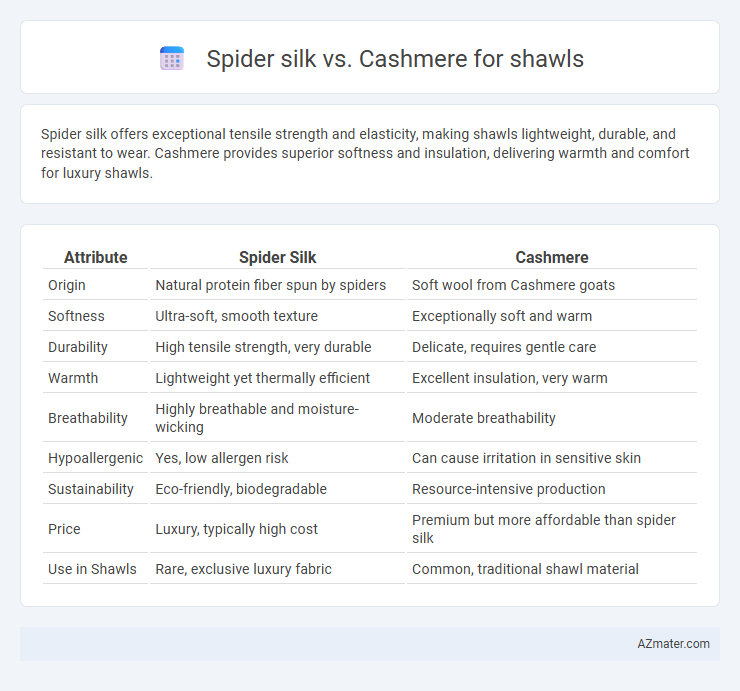Spider silk offers exceptional tensile strength and elasticity, making shawls lightweight, durable, and resistant to wear. Cashmere provides superior softness and insulation, delivering warmth and comfort for luxury shawls.
Table of Comparison
| Attribute | Spider Silk | Cashmere |
|---|---|---|
| Origin | Natural protein fiber spun by spiders | Soft wool from Cashmere goats |
| Softness | Ultra-soft, smooth texture | Exceptionally soft and warm |
| Durability | High tensile strength, very durable | Delicate, requires gentle care |
| Warmth | Lightweight yet thermally efficient | Excellent insulation, very warm |
| Breathability | Highly breathable and moisture-wicking | Moderate breathability |
| Hypoallergenic | Yes, low allergen risk | Can cause irritation in sensitive skin |
| Sustainability | Eco-friendly, biodegradable | Resource-intensive production |
| Price | Luxury, typically high cost | Premium but more affordable than spider silk |
| Use in Shawls | Rare, exclusive luxury fabric | Common, traditional shawl material |
Introduction: Spider Silk vs Cashmere Shawls
Spider silk and cashmere are two luxurious materials used for shawls, each offering unique benefits in texture and durability. Spider silk is renowned for its exceptional strength, lightweight nature, and natural elasticity, providing a smooth yet resilient fabric ideal for delicate shawls. Cashmere, derived from the soft undercoat of cashmere goats, is prized for its unmatched warmth, softness, and breathability, making it a timeless choice for cozy, elegant shawls.
Natural Origins and Production Processes
Spider silk and cashmere both originate from natural sources, with spider silk derived from the protein secreted by certain spider species and cashmere harvested from the soft undercoat of cashmere goats. The production of spider silk involves the careful extraction or bioengineering of silk proteins, followed by spinning into fibers, a process that is highly labor-intensive and rare due to the challenges of farming spiders. Cashmere production requires shearing goats during seasonal molting, sorting, and dehairing fibers to achieve softness, a traditional process with deep cultural roots in regions like Mongolia and Kashmir.
Unique Fiber Structures Compared
Spider silk features a protein-based fiber structure composed of fibroin, providing exceptional tensile strength and elasticity, making it one of the toughest natural fibers known. Cashmere, derived from the fine undercoat of cashmere goats, consists of keratin fibers characterized by a hollow medulla and fine diameter, granting superior softness and insulation. The unique molecular makeup of spider silk allows for remarkable durability and lightweight warmth, whereas cashmere excels in thermal regulation and luxurious comfort due to its natural crimp and fiber diameter.
Softness and Comfort: Sensation and Feel
Spider silk exhibits an extraordinary softness and a unique smooth texture that feels almost weightless against the skin, making it an exceptional choice for delicate shawls. Cashmere is renowned for its luxurious warmth and unparalleled softness derived from the fine undercoat of Cashmere goats, offering a cozy and comforting sensation during wear. While spider silk provides a cooler, airy comfort ideal for sensitive skin, cashmere delivers rich warmth and plush softness suitable for colder climates.
Strength and Durability: Which Lasts Longer?
Spider silk exhibits exceptional tensile strength and remarkable durability, surpassing many natural fibers, including cashmere. Cashmere, while luxurious and soft, is more delicate and prone to pilling and wear over time, making it less resilient for long-term use. For shawls requiring longevity and resistance to abrasion, spider silk offers superior strength and lasting performance compared to cashmere.
Thermal Properties and All-Season Comfort
Spider silk offers exceptional thermal regulation due to its unique protein structure, providing lightweight warmth without overheating, making it ideal for all-season shawls. Cashmere excels in insulating warmth and softness but may retain more heat, better suited for colder climates rather than transitional seasons. Combining spider silk's breathability with cashmere's insulation results in a shawl that balances temperature control and luxurious comfort throughout the year.
Breathability and Moisture Management
Spider silk offers superior breathability compared to cashmere, allowing air to circulate more effectively and keeping the wearer cool. Its unique protein structure efficiently wicks moisture away from the skin, promoting quick drying and reducing discomfort caused by sweat. Cashmere, while soft and insulating, tends to retain moisture longer and provides less ventilation, making spider silk the better choice for regulating temperature and moisture in shawls.
Environmental Impact and Sustainability
Spider silk offers exceptional environmental benefits due to its biodegradability and production involving minimal resource consumption, making it a sustainable alternative in textile manufacturing. Cashmere, though luxurious and warm, faces significant sustainability challenges including overgrazing by goats, which leads to land degradation and biodiversity loss. Opting for spider silk shawls reduces ecological footprint through renewable material sourcing and lower greenhouse gas emissions compared to cashmere production.
Cost and Accessibility in the Market
Spider silk shawls remain rare and expensive due to the complex and labor-intensive process of harvesting silk from spiders, making them a luxury niche product often priced significantly higher than cashmere shawls. Cashmere shawls benefit from a well-established supply chain and widespread availability, which contributes to a more accessible price range and easier market access for consumers. The high cost and limited production of spider silk result in low market accessibility, contrasting sharply with the relative affordability and abundance of cashmere options.
Choosing the Best: Which Shawl is Right for You?
Spider silk shawls offer unparalleled strength, lightweight comfort, and natural temperature regulation, making them ideal for those seeking luxury with durability. Cashmere shawls provide exceptional softness and warmth due to the fine goat fibers, perfect for colder climates and traditional elegance. Choosing between spider silk and cashmere depends on your priorities for texture, insulation, and long-term wearability.

Infographic: Spider silk vs Cashmere for Shawl
 azmater.com
azmater.com